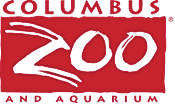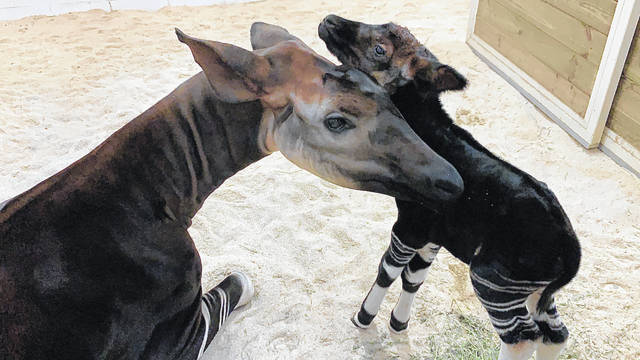

POWELL — The Columbus Zoo and Aquarium is celebrating the birth of a male okapi calf on Friday, May 8, at 3:54 a.m. to mother, Damisi, and father, El Jewar.
The dedicated Animal Care team in the zoo’s Congo Expedition region had been on birth watch since April 21 and, through a mounted camera, monitored Damisi as she delivered her calf to ensure that she did not have any complications. They noted the first nursing attempt at 6:45 a.m., followed by confirmed nursing at 8:31 a.m. As nursing has been successful and Damisi is an experienced mother (after having raised male calf, Daktari, born in 2014), the first well check will happen in a couple of weeks to minimize potential disruptions as Damisi and her calf bond.
Because okapi calves cannot control their own body temperature (or thermoregulate) for approximately a couple of months, Damisi and her newborn will also need to stay in a temperature-controlled indoor environment behind the scenes so he can nest. In the meantime, the team also quietly checks on them as they bring food for the four adult okapis, Damisi, El Jewar, Karatasi and Miliki, and clean the barn.
The pairing of Damisi and El Jewar was recommended by the Species Survival Plan® (SSP), a program coordinated by the Association of Zoos and Aquariums (AZA) to maintain genetic diversity of threatened and endangered species in human care. Damisi, who is 14 years old, was born at the Dallas Zoo and came to the Columbus Zoo in September 2007, while 24-year-old El Jewar was also born at the Dallas Zoo and arrived at the Columbus Zoo in June 2000. This calf, who is currently unnamed, is the sixth okapi calf to be born at the Columbus Zoo since the first was born in 2003.
“The birth of this calf is very special as this incredible species continues to face many challenges in its native range. The Columbus Zoo remains dedicated to saving wildlife and wild places, and we are proud to be a part of this managed breeding program and other conservation initiatives working to protect okapis,” said Columbus Zoo and Aquarium President/CEO Tom Stalf.
According to the International Union For Conservation of Nature (IUCN) Red List of Threatened Species™, okapis are listed as endangered. Habitat loss and deforestation, as well as poaching and previous civil unrest in the okapis’ range, have resulted in declining populations of this species, which is found only in forests of northeastern Democratic Republic of Congo (DRC). A unique animal with its large, upright ears, elongated neck, shiny brown body and black-and-white striped hindquarters that provide camouflage in the dense forests, the okapi may look like it resembles a horse or zebra, but it is actually the only living relative of the giraffe. Like giraffes, okapis have prehensile tongues for stripping buds and leaves from branches and underbrush, and male okapis have fur-covered ossicones, which are horn-like structures on their heads.
Okapis are highly elusive and mostly solitary, and up until the end of the 1800s and beginning of the 20th century, the species was unknown to the scientific community. While the okapi became protected in 1933 in the DRC, where it is a national and cultural symbol, recent research found that increased human activities have resulted in the okapi population plummeting by over 50 percent in just three generations for this species (24 years). The total number of okapis remains uncertain, but scientists estimate that only between 35,000 and 50,000 remain, with some researchers estimating the population to consist of even fewer individuals.
The Columbus Zoo is a long-time supporter of the Okapi Conservation Project working in the DRC to help protect the okapi through habitat preservation and community-based initiatives that benefit the okapi, as well as the people with whom they share the forests and its resources.
“Researchers continue to learn more about this species every day, and as this calf grows, we, too, expand on knowledge of these animals. Through these collaborative efforts, our guests’ support and the involvement of communities living within okapis’ native range, all of us can play a big role in helping to protect them. We are very excited to welcome this adorable okapi calf, as he represents that hope for his species’ future,” said Audra Meinelt, curator of the Columbus Zoo’s Congo Expedition region.



